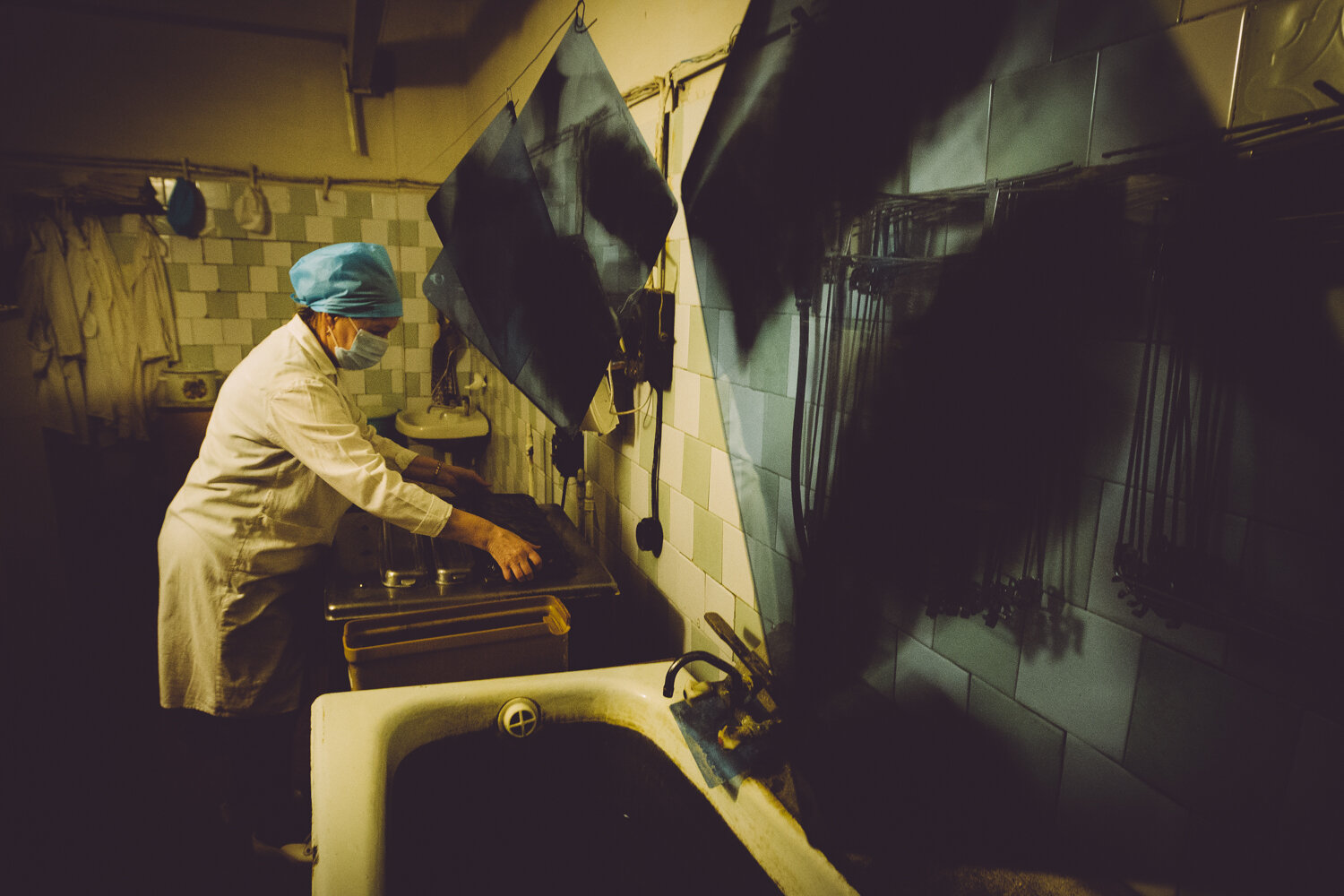War Scars: How the Conflict in Eastern Ukraine Changed its Society
Vadim Sviridenko, born 1973 in Kyiv. He was mobilized in the summer of 2014 as a military physician, then wounded and captured by the enemy during winter. Here Vadim is posing for an American visa to participate at athletic marathons for military personnel in the U.S. © Alexander Chekmenev, War Torn (2014-2015).
WAR SCARS
The horrors of war have always left deep scars on any country. As a conflict in Eastern Ukraine continues to destroy communities and families, Ukrainian photographers have embarked upon a mission to call attention to the destruction of their society. Rather than looking at the combat itself, the photographers presented here look at the bigger picture, telling us how the lives of their subjects have been changing in the past decade.
Varvara Frolova, 85, posing with an icon that her grandfather painted in 1947. Varvara's apartment was destroyed in the bombings and the icon was among the only whole pieces left. © Alexander Chekmenev, War in Donbass (2014-2016).
Alexander Chekmenev (b. 1969) began his career in a post-Soviet Ukraine, mired by an economic crisis. He started taking pictures in the turbulent 90s, capturing everyday people trying to survive on the streets. Chekmenev offered a unique perspective on a heavy-industrial, deserted Eastern Ukraine, and now continues to explore its development as the region becomes increasingly engaged in a civil war. To photograph his two recent projects, he continued working in his home region and embedded himself directly into the war zone. In his photographs from the War in Donbass series, Chekmenev organizes people next to destroyed buildings, the two standing side by side, both subjects just as shattered as the other. The people's faces look devasted with the loss of their homes — a place traditionally seen as a safe haven that is now shattered.
Aliona with her son Egor, 6, and daughter Aliona, 11, pose for the portrait in Nikolaevka. When their apartment was bombed, the family had to jump out of the window to survive. Egor refuses to stay with his grandmother, who lives on the fifth floor, because it would be impossible to jump out of the window in case of another bombing. © Alexander Chekmenev, War in Donbass (2014-2016).
In his War-Torn project, the artist visits hospitals with young veterans who lost their limbs in the conflict. Capturing the young and wounded soldiers laying in their hospital beds, Chekmenev again shares the impact of war on the society. As far as he explores, war leaves a mark on everyone, crawling into one’s bed when they least expect it and taking away the things we value most, like our homes or our physical abilities.
Sergey Gordeychuk, 35, father of two. When he got wounded, his unit was near the village of Marinovka, a few kilometers from the Russian border. © Alexander Chekmenev, War Torn (2014-2015).
Alexander Chalapchiy, 28, teacher of vocational schools. He was one of the first volunteers to enter the front, saying he could not let his students fight alone. Despite severe amputations, Alexander smiles through most of his journey, and is now a business owner and a father of two children. © Alexander Chekmenev, War Torn (2014-2015).
As the civil war destroys people’s homes and disrupts family life, Ukranian citizens have been pushed to migrate en masse, catalyzing a humanitarian crisis as displaced migrants often have no documents, money or access to health care. In Ukraine, that crisis added to an already existing tuberculosis epidemic, taking at least 40 lives every day.
Drying of X-rays. Zhdanovka penal colony #3, Donbass, February 2011. It had to be done in the old-fashioned method because of lack of funding © Maxim Dondyuk.
Maxim Dondyuk (b.1983), the second photographer featured in this piece, created this project to explore the TB epidemic in Ukraine in 2010-2012, a few years before the war first started. With the epidemic still continuing, his work stays highly relevant once more. His photographs are powerful, showing the struggling ill, the empty, cold hospital corridors, and the “ancient” inefficient methods the doctors are forced to use in the absence of adequate funding. Maxim’s work speaks for itself; in his photos, the horror of slow, painful death is omnipresent in the thin, exhausted people. With about one million displaced people, the Ukrainian TB epidemic will keep flourishing with no end in sight.
Surgical removal of the spine parts affected with TB on Helen, born 1954. Donbass, December 2010. © Maxim Dondyuk
Leonid, 1954, and Anatoly, 1936. August 2011 ©Maxim Dondyuk
In the past century, war and conflict became almost mundane events. As millions of people are forced to migrate and thouthands die, citizens are left to choose their reactions to violence. For photographers featured today, the answer to war is to highlight the scars it leaves on their society. In their work, one could find a raw presentation of daily sufferings of people who were misfortunate enough to get involved into an armed conflict. As the new decade begins, photographers like Dondyuk and Chekmenev continue exhibiting how disastrous a war can be, and how deep the scars the society will be left with even before it passes.
Mrs. Chavela next to her destroyed house, built by her husband. The house burnt down when it was hit by a shell, along with all their belongings. Alexander Chekmenev, War in Donbass (2014-2016).
















